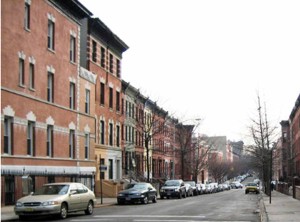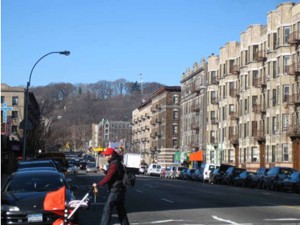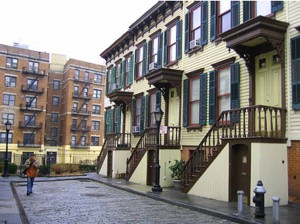Community Overviews
*Please note: Dated information compiled in 2008Harlem
 Harlem’s history is indeed America’s history: as one of the world’s best-known neighborhood, Harlem has a rich history that has positively impacted the life of many people throughout America. While it is best known as the center of African-American and Latin culture, Harlem has also been home for many decades to other ethnic groups including Jews, Irish, Italians, Chinese, and others. During the early 20th century, the community became known as “the spiritual home of the Negro protest movement.” when the NAACP became active (1910) and Marcus Garvey’s Universal Negro Improvement Association began in 1916. Also during this time period, A. Philip Randolph organized the Brotherhood of Sleeping Car Porters and both W.E.B. DuBois and James Weldon Johnson lived and published in Harlem. More significantly, in the 1920s, Harlem became the center of a flowering of black culture known as the Harlem Renaissance. This Renaissance was a time of prolific artistic production in music, art, theater, dance, literature and social thought where artist and intellectuals explored the historical experience of Black America. By 1941, Black Harlemites also took positions in the elected political infrastructure of New York with the election of Adam Clayton Powell Jr. to the City Council and in 1989, Harlem increased its political clout when David N. Dinkins was elected the first Black mayor of New York City. Despite these triumphs, many Harlem residents experience disparities in healthcare with Central Harlem being the epicenter of some of the most protracted socio-economic challenges in New York City. For example, Harlem has unemployment rates higher than the New York City average as well as high mortality rates. A study published in 1990 found that young black women in Harlem had a 65% chance of surviving to age 65, which is about the same for women in India! Currently the health issues impacting Harlem residents include disproportionately high rates of heart disease, diabetes, obesity and cancer. Harlem Hospital Center, the bedrock of the Harlem community since 1887, provides a wide range of medical, surgical, diagnostic, therapeutic and family support services to the residents. In response to these statistics, which reflect negatively on Harlem, a group of concerned residents started Harlem Week, motivated by their belief in the community’s cultural richness, architectural beauty and potential for greatness. The intent was to put Harlem back at the forefront of urban, cultural, ethnic, educational, political, recreational and religious leadership. It is now a month long tribute to Harlem¹s glorious history and to a community of people who live, work, learn and worship together. What is truly unique about Harlem is the resilience of its people who continue to strive despite systemic racial and economic policies that impede the community’s affirmation and self-determination. Most recently, the new wave of gentrification seems destined to sap the very essence of a people determined to hold onto their spirituality as well as the poetry of their existence. Central Harlem is defined as the area stretching from 110th Street at its southern border to 145 Street; from 5th Avenue at its eastern border to Manhattan Avenue. Its current racial/ethnic demographics are 67% African-American, 20% Latino, 8% White, 3% Asian and 2% other.
Harlem’s history is indeed America’s history: as one of the world’s best-known neighborhood, Harlem has a rich history that has positively impacted the life of many people throughout America. While it is best known as the center of African-American and Latin culture, Harlem has also been home for many decades to other ethnic groups including Jews, Irish, Italians, Chinese, and others. During the early 20th century, the community became known as “the spiritual home of the Negro protest movement.” when the NAACP became active (1910) and Marcus Garvey’s Universal Negro Improvement Association began in 1916. Also during this time period, A. Philip Randolph organized the Brotherhood of Sleeping Car Porters and both W.E.B. DuBois and James Weldon Johnson lived and published in Harlem. More significantly, in the 1920s, Harlem became the center of a flowering of black culture known as the Harlem Renaissance. This Renaissance was a time of prolific artistic production in music, art, theater, dance, literature and social thought where artist and intellectuals explored the historical experience of Black America. By 1941, Black Harlemites also took positions in the elected political infrastructure of New York with the election of Adam Clayton Powell Jr. to the City Council and in 1989, Harlem increased its political clout when David N. Dinkins was elected the first Black mayor of New York City. Despite these triumphs, many Harlem residents experience disparities in healthcare with Central Harlem being the epicenter of some of the most protracted socio-economic challenges in New York City. For example, Harlem has unemployment rates higher than the New York City average as well as high mortality rates. A study published in 1990 found that young black women in Harlem had a 65% chance of surviving to age 65, which is about the same for women in India! Currently the health issues impacting Harlem residents include disproportionately high rates of heart disease, diabetes, obesity and cancer. Harlem Hospital Center, the bedrock of the Harlem community since 1887, provides a wide range of medical, surgical, diagnostic, therapeutic and family support services to the residents. In response to these statistics, which reflect negatively on Harlem, a group of concerned residents started Harlem Week, motivated by their belief in the community’s cultural richness, architectural beauty and potential for greatness. The intent was to put Harlem back at the forefront of urban, cultural, ethnic, educational, political, recreational and religious leadership. It is now a month long tribute to Harlem¹s glorious history and to a community of people who live, work, learn and worship together. What is truly unique about Harlem is the resilience of its people who continue to strive despite systemic racial and economic policies that impede the community’s affirmation and self-determination. Most recently, the new wave of gentrification seems destined to sap the very essence of a people determined to hold onto their spirituality as well as the poetry of their existence. Central Harlem is defined as the area stretching from 110th Street at its southern border to 145 Street; from 5th Avenue at its eastern border to Manhattan Avenue. Its current racial/ethnic demographics are 67% African-American, 20% Latino, 8% White, 3% Asian and 2% other.
Inwood
 Inwood is a small neighborhood of northern Manhattan that extends from the Harlem River to the north and east, and the Hudson River to the west. It extends south to Fort Tryon Park and Dyckman Street. Inwood is typically defined by the 10034 postal ZIP code, although it extends into some of the 10040 ZIP code to the south. Legend has it that in Inwood Hill Park on May 24, 1626 Peter Minuit, the director general of the Dutch colony New Netherland, bought the island of Manhattan from the Lenape Indians for 60 Dutch guilders and some trinkets. A plaque commemorating the location of the sale is in Inwood Hill Park, 196 acres of the only natural forest and salt marsh left in Manhattan. For much of the 20th century, the residents of Inwood were mostly of Irish and Jewish descent. Up until recently, the neighborhood exhibited a strong Irish identity with many Irish shops, and pubs. However, during the 1970s and 1980s, the majority of Inwood’s Irish residents moved to the City’s outer boroughs and suburbs. During the same period that Irish were leaving Inwood, there was a substantial increase in the number of immigrants arriving from the Dominican Republic. Today, Inwood has a predominantly Dominican population, particularly in the parts of the neighborhood east of Broadway. Inwood is a mix of commercial streets, such as Dyckman St and 207th st., which are filled with shops, restaurants, and bars, and forested parkland including High bridge Park & Fort Tryon parks to the south, and Inwood Hill Park to the northwest. According to Census data from 2000, Inwood has approximately 50,000 residents. Inwood is about 77% Hispanic, 6% African-American, 13% Caucasian, and 1.6% Asian. The median annual household income for the area is approximately $30,000.
Inwood is a small neighborhood of northern Manhattan that extends from the Harlem River to the north and east, and the Hudson River to the west. It extends south to Fort Tryon Park and Dyckman Street. Inwood is typically defined by the 10034 postal ZIP code, although it extends into some of the 10040 ZIP code to the south. Legend has it that in Inwood Hill Park on May 24, 1626 Peter Minuit, the director general of the Dutch colony New Netherland, bought the island of Manhattan from the Lenape Indians for 60 Dutch guilders and some trinkets. A plaque commemorating the location of the sale is in Inwood Hill Park, 196 acres of the only natural forest and salt marsh left in Manhattan. For much of the 20th century, the residents of Inwood were mostly of Irish and Jewish descent. Up until recently, the neighborhood exhibited a strong Irish identity with many Irish shops, and pubs. However, during the 1970s and 1980s, the majority of Inwood’s Irish residents moved to the City’s outer boroughs and suburbs. During the same period that Irish were leaving Inwood, there was a substantial increase in the number of immigrants arriving from the Dominican Republic. Today, Inwood has a predominantly Dominican population, particularly in the parts of the neighborhood east of Broadway. Inwood is a mix of commercial streets, such as Dyckman St and 207th st., which are filled with shops, restaurants, and bars, and forested parkland including High bridge Park & Fort Tryon parks to the south, and Inwood Hill Park to the northwest. According to Census data from 2000, Inwood has approximately 50,000 residents. Inwood is about 77% Hispanic, 6% African-American, 13% Caucasian, and 1.6% Asian. The median annual household income for the area is approximately $30,000.
Washington Heights
 Washington Heights (WH) is known for its rich history, diverse culture and lots of beautiful green areas. It acquired its name from Fort Washington, a fort built at the highest point of the Manhattan Island during the American Revolutionary war. WH extends north from 155th Street to Dyckman Street and spans from the Hudson to the Harlem River. WH is predominantly a Dominican neighborhood where Spanish is spoken on the streets and at local businesses. As a result, it is sometimes referred as Quisqueya Heights. Quisqueya, is the name given by the Tainos to the island of Hispaniola, which means “mother of the earth.” In WH there is also a Jewish community that first established itself during World War II. Currently, Washington Heights is home to Yeshiva University and several Jewish synagogues. Farms and country mansions of wealthy people once populated WH. Today, the only surviving mansion from the Pre-Revolutionary War era that exists in Manhattan is the Morris-Jumel Mansion, located at 160th street and Edgecombe Avenue. Washington Heights gave birth to the world famous baseball team the New York Yankees. The New York Yankees were once called the Highlanders because their ballpark was built in the high land area that is now the NY Presbyterian Hospital on Broadway and 168th Street. Demographics: According to the 2000 Census, Washington Heights has a population of 208,414 people. The racial/ethnic breakdown is as follows: 74.1% Hispanic, 13.6% white (non-Hispanic), 8.4% black (non-Hispanic), and 2.1% Asian/Pacific Islander.
Washington Heights (WH) is known for its rich history, diverse culture and lots of beautiful green areas. It acquired its name from Fort Washington, a fort built at the highest point of the Manhattan Island during the American Revolutionary war. WH extends north from 155th Street to Dyckman Street and spans from the Hudson to the Harlem River. WH is predominantly a Dominican neighborhood where Spanish is spoken on the streets and at local businesses. As a result, it is sometimes referred as Quisqueya Heights. Quisqueya, is the name given by the Tainos to the island of Hispaniola, which means “mother of the earth.” In WH there is also a Jewish community that first established itself during World War II. Currently, Washington Heights is home to Yeshiva University and several Jewish synagogues. Farms and country mansions of wealthy people once populated WH. Today, the only surviving mansion from the Pre-Revolutionary War era that exists in Manhattan is the Morris-Jumel Mansion, located at 160th street and Edgecombe Avenue. Washington Heights gave birth to the world famous baseball team the New York Yankees. The New York Yankees were once called the Highlanders because their ballpark was built in the high land area that is now the NY Presbyterian Hospital on Broadway and 168th Street. Demographics: According to the 2000 Census, Washington Heights has a population of 208,414 people. The racial/ethnic breakdown is as follows: 74.1% Hispanic, 13.6% white (non-Hispanic), 8.4% black (non-Hispanic), and 2.1% Asian/Pacific Islander.
Photo credits: NYC Salt
